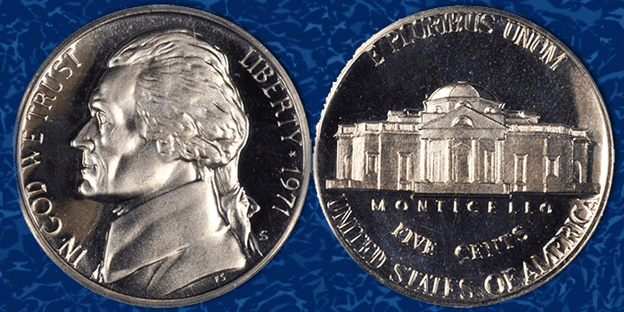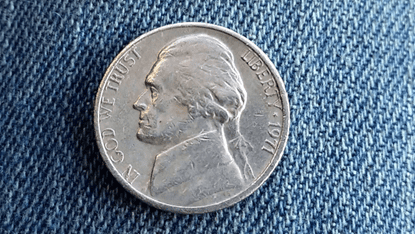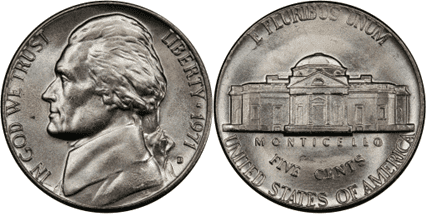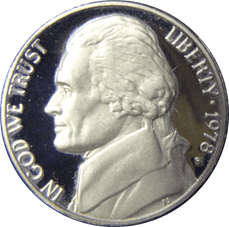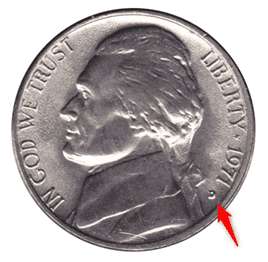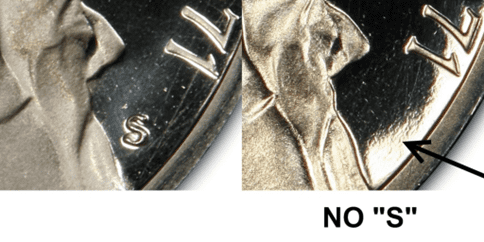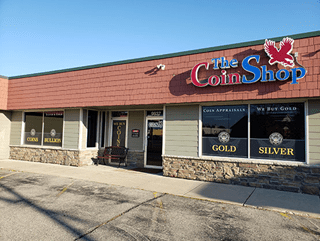What Is A 1971 Nickel Made Of?

photo source: Coinweek
The 1971 Nickel or Jefferson nickel is composed of 75% copper and 25% nickel. It has a diameter of 21.2 mm and a mass of 5 grams.
The design of the 1971 Nickel features the bust of Thomas Jefferson inspired by Jean-Antoine Houdon’s artwork on the obverse side. Jefferson is facing the left side with the words “IN GOD WE TRUST,” which arcs clockwise. The right side includes the inscription “LIBERTY 1971.”
On the reverse side, you’ll find the Monticello mansion’s front view. Monticello means little mountain or mound. Jefferson himself designed the structure.
On top of the Monticello, the US motto is written: E PLURIBUS UNUM, meaning out of many, one. Beneath the mansion are the words, “FIVE CENTS.” Finally, you’ll find the “UNITED STATES OF AMERICA” below the five cents.
The 1971 nickel was made out of necessity. The United States Mint decided to create new proof Jefferson nickel master dies since the old ones were already worn out and its details were fading away.
In 1971, the San Francisco Mint halted the production of nickels for circulation. Because of this, the 1971-S became the first five-cent coin since 1878 to be produced in Proof finish. Since then, all nickels produced in San Francisco were Proofs.
Did They Ever Make A Copper-Nickel?
Yes, they made copper nickels. These coins are made of copper and nickels or what they call the cupronickel.
If you want to be sure you have a copper-nickel coin, there are a few things you can do. You can do a drop test and listen to the sound they make. A copper-nickel coin would have a dull thud. This is different from silver coins which have a higher pitched sound.
Moreover, you can take a look at old coins. Copper-nickel coins will have a copper tint on the coin while silver coins tarnish.
1971 Jefferson Nickel Varieties
The 1971 nickel comes in different varieties because of the redesigning and recutting process. The obverse side has the ODV-021 variety. The “TR” in the word “TRUST” was made slightly thinner.
The reverse side comes in two varieties, the RDV-005 and RDV-006. The RDV-005 shows Monticello’s rooftop railings with a low relief look. On the other hand, RDV-006 comes with a stronger rooftop railings appearance.
There are also some errors that were made, which gave birth to a unique variety.
Usually, the standard Jefferson Nickel coins include the following:
1971 Nickel With No Mint Mark
Mint Mark: None
Type: Jefferson Nickel
Edge: Smooth
Face Value: 0.10 USD
Market price: $0.05 to $20.00 (or more)
Coins produced: 316,144,000

photo source: Coin Collection Fun
1971 D Nickel
Mint Mark: D
Type: Jefferson Nickel
Edge: Reeded
Face Value: 0.10 USD
Market price: $0.05 to $20.00 (or more)
Coins produced:

photo source: PCGS
1971 S Nickel
Mint Mark: D
Type: Jefferson Nickel
Edge: Reeded
Face Value: 0.10 USD
Market price: $0.05 to $20.00 (or more)
Coins produced: 316,144,000

photo source: Numista
The “D” mint mark means that the coin was struck in Denver. The “S” mint mark means that the coin was struck in San Francisco.

photo source: USA Coin Book
You can find the mint mark below the bust of Thomas Jefferson. It’s a single small letter. If you have a good eye, you should easily find it.
The most special and rarest type of the 1971 nickel would be the “No S” Jefferson nickel. The coin is basically the same as other nickels. What’s lacking is the S mint mark.

photo source: PCGS
So, how did this happen? First of all, the nickel dies were produced by the Philadelphia Mint. They needed to send these dies to San Francisco for producing the 1971 nickel. However, the people responsible for sending the die to San Francisco mistakenly sent an incomplete die. It was too late for them to discover that the die they sent lacked the “S” mint mark.
According to the estimates at that time, there were about 1,655 nickels that were produced without the mint mark.
How Much Is A 1971 Jefferson Nickel Worth Today?
If you’re going to ask about the melt value of the 1971 Jefferson nickel, it would only be the same as its face value, which is $0.5.
An ordinary and standard 1971 Jefferson nickel would only sell for about $1. Some are even not worth selling since their worth is the same as their face value.
Just to give you an example, a Jefferson Nickel with a PR65, PR66 and PR67 grade would sell for between 50 cents and 1 dollar.
Those with better grades would sell more, but only slightly. On eBay, you’ll find Jefferson nickels being sold at $5 apiece. These coins are usually graded PR-69.
The Numismatic Guaranty Company (NGC) has not graded even a single Jefferson nickel PR70. However, reports say that the Professional Coin Grading Service (PCGS) has rated one nickel as PR70.
When it comes to value, you would want to have the “No S” variety of Jefferson Nickel. Since it is the rarest variety, it has much more value than other low-grade nickels.
In auctions, the “No S” Jefferson nickel can sell between $1,000 to $1,500. In January 2012, Heritage FUN Signature Auction sold a rare Jefferson nickel at a cost of $2,070.
How Does The Grading System Work?
The Sheldon Scale is used by numismatists to provide a numerical value to coins. The Sheldon Scale goes from poor (P-1) to perfect mint state (P-1) (MS-70). Coins were originally evaluated using words to reflect their condition (Good, Fair, Excellent, Etc.). Unfortunately, coin collectors and dealers had different ideas about what each of these terms represent.
Professional numismatists joined together in the 1970s and established CoinGrading standards. These numismatists now assign grades at key places on the seventy-point scale, using the most regularly utilized numeric points in conjunction with the original adjective grade. The following are the most common coin grades:
-
-
- (P-1) Poor – Indistinguishable and probably damaged; if used, must have a date and mintmark; otherwise, rather battered.
- (FR-2) Fair – Nearly smooth, but without the damage that a coin graded Poor often possesses. The coin must have enough detail to be identified.
- (G-4) Fair – Inscriptions have merged into the rims in some areas, and important elements have been mostly erased.
- (VG-8) Very Good- A little weathered, but all of the primary design elements are visible, albeit faintly. There is little if any, central detail left.
- (F-12) Good – The item is very worn, yet the wear is even, and the overall design details stand out clearly. Rims are almost completely isolated from the field.
- (VF-20) Very Fine – Moderately weathered, with some finer features still visible. The motto or all letters of LIBERTY are readable. Both sides of the coin have entire rims that are separated from the field.
- (EF-40) Extremely Fine – Gently used; all gadgets are visible, and the most important ones are bold. The finer details are bold and clear, however, light wear may be seen.
- (AU-50) Uncirculated – Slight evidence of wear on the coin’s design’s high points; may have contact marks; eye appeal should be adequate.
- (AU-58) Uncirculated Choice – Slight traces of wear, no severe contact marks, almost full mint shine, and great eye appeal.
- (MS-60) Mint State Basal – Strictly uncirculated; no indication of wear on the coin’s highest points, but an unsightly coin with reduced luster, visible contact marks, hairlines, and other flaws.
- (MS-63) Mint State Acceptable – Uncirculated, but with contact scratches and nicks, little reduced shine, but otherwise appealing appearance. The strike is weak to average.
- (MS-65) Mint State Choice – Uncirculated with great mint shine, very little contact blemishes, and exceptional eye appeal. The strike is unusually severe.
- (MS-68) Mint State Premium Quality – Uncirculated with superb luster, no obvious contact marks to the naked eye, and exceptional eye appeal. The strike is quick and appealing.
- (MS-69) Almost Perfect Mint State – Uncirculated with perfect brilliance, a sharp and appealing strike, and extremely good eye appeal. A near-perfect coin with minor imperfections in the planchet, strike, and contact markings (seen only under 8x magnification).
- (MS-70) Mint State Perfect – Under 8x magnification, there are no tiny imperfections discernible; the strike is crisp, and the coin is perfectly centered on a beautiful planchet. Rarely seen on a coin, this coin is bright and whole, with original luster and exceptional eye appeal.
-
Where To Buy Or Sell 1971 Nickels?
There are different places where you can buy or sell 1971 nickels. Like what was already mentioned, coin dealers are among the best places to find what you’re looking for.

photo source: ACXShop
Antique stores may also offer to buy your coins or sell their coins to you. You can also look for local collectors and coin clubs. Having a wider network of coin enthusiasts and like-minded people can open up a huge opportunity in finding the right coin for you.
Finally, you can always go online. eBay, Amazon, and Etsy are among the most popular marketplaces on the Internet. Depending on where you are, there might also be online and brick-and-mortar stores that could meet your needs.
FAQs
Where is the mint mark on a 1971 Jefferson nickel?
You can find the mint mark on a 1971 Jefferson nickel just beneath the “1971” and near the end of the ponytail of Jefferson on the obverse side of the coin.
How can you tell if a nickel is proof?
A nickel becomes a proof when it is struck twice. The extra strike makes the coin look shinier, more detailed, and cleaner.
That’s why if you compare a proof against an ordinary nickel, you’ll see that the proof coin has a design that pops out more. Not only that but nickel proofs have this mirror-like background on them.
What is the rarest year for a nickel?
The rarest nickel is the “No S” 1971 Jefferson nickel. This coin doesn’t have the usual mint mark on it. This happened because an incomplete die was used.

